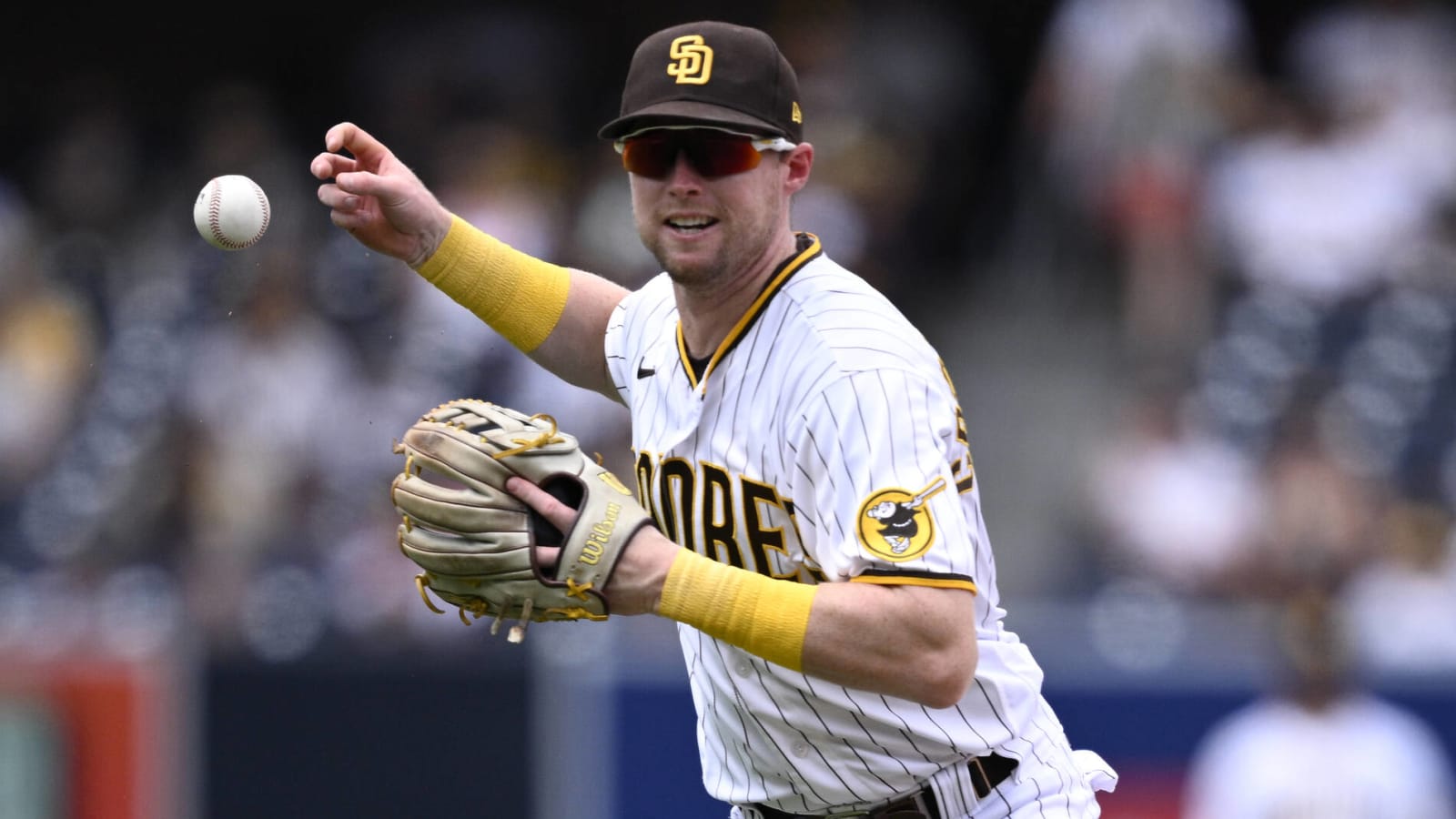
After the Scott Barlow and Juan Soto/Trent Grisham trades, Roster Resource projects the Padres payroll for the 2024 season in the $154M range. They’re at roughly $209M in luxury tax commitments, about $28M shy of next year’s lowest threshold.
San Diego now has some space to add, but the series of free-agent losses and trade departures has created a number of holes. With a need for at least one starting pitcher, a back-end reliever and likely multiple outfielders, the front office could continue looking for ways to create spending room. One path the front office is seemingly pursuing: moving some of the money owed to Jake Cronenworth.
MLB.com’s Mark Feinsand tweeted last week that Cronenworth had emerged as a trade candidate. Dennis Lin of the Athletic similarly wrote over the weekend the Padres were open to discussions on the fifth-year infielder. That’s to be expected, as Cronenworth is coming off the worst season of his career.
That’s not ideal for a player entering the first season of a seven-year contract. Last spring, San Diego signed Cronenworth to an $80M extension covering the 2024-30 campaigns. It was an odd decision at the time, as the Padres already had arbitration control through his age-32 season. It looks worse in hindsight after his 2023 performance.
Cronenworth hit .229/.312/.378 with 10 home runs through 522 plate appearances. He had the lowest mark of his career in all three slash stats. That’d be more tolerable at his natural second base position, but the Friars also kicked him primarily to first base after signing Xander Bogaerts to keep Ha-Seong Kim at the keystone. Cronenworth’s hit-over-power approach isn’t a great fit at first base, where most teams receive far more offensive productivity. Among 25 primary first baseman to reach 500 plate appearances, Cronenworth ranked 23rd in both on-base percentage and slugging. His season finished in late August when he fractured his right wrist.
The Padres certainly expect better than that in 2024. Going into last season, the Michigan product had a much superior .256/.338/.431 career batting line. Yet he has also trended downwards offensively in each season since his rookie year. With Kim and Bogaerts likely to again occupy the middle infield, Cronenworth isn’t a great fit for the San Diego roster. Offloading a portion of his contract and bringing in a more traditional slugging first baseman could mollify some of their problems getting production from the bottom half of the lineup.
San Diego wouldn’t find a taker for the entire contract. Aside from a $2M signing bonus, Cronenworth’s extension hasn’t yet kicked in. Were he a free agent this offseason, he would not receive seven years or $78M.
For reference, Jeimer Candelario was on the open market this winter. He’s a few weeks older than Cronenworth, has nearly identical offensive production over the past four seasons, and is coming off a much better ’23 campaign (.251/.336/.471 with 22 homers). Candelario signed a three-year pact that guaranteed $45M. Even with Cronenworth having a slight defensive edge based on his ability to play an above-average second base, he likely wouldn’t have beaten Candelario money.
The Padres owe Cronenworth a $7M salary for next season, followed by $11M in 2025. He’s due $12M annually between 2026-30, covering his age 32-36 campaigns. If the Friars were simply prioritizing shedding next year’s money, they’d likely find a trade partner. Paying $7M for Cronenworth in ’24 is good value, particularly if a team can move him back to second base. The Padres would have to agree to kicking in some money beyond the next season or two in order to reduce the longer-term downside for an acquiring team.
Whit Merrifield and Tim Anderson are the top open market options. Neither is demonstrably better than Cronenworth. There are other trade possibilities (e.g. Jorge Polanco, Kyle Farmer, Jonathan India) but teams looking for second base help could have to turn to the trade market.
The Royals project to turn the position back to Michael Massey, who hit .229/.274/.381 a season ago. K.C. has a decent amount of long-term payroll room and generally prefers hit-over-power, athletic players who align with their spacious home park. The Red Sox had a revolving door at second base last season, receiving a .240/.286/.376 line overall. Chief baseball officer Craig Breslow acknowledged last week the Sox were likely to trade for a second baseman, although he called a right-handed hitter an ideal pickup.
Seattle could look to improve upon Josh Rojas. Cronenworth would align with their goal of adding more contact if they view him as reasonable buy-low target. The Angels and Blue Jays may add an infielder, although their respective in-house options might be productive enough they don’t see Cronenworth as a clear upgrade.
Teams like the Brewers (Brice Turang), Rockies (Brendan Rodgers) and Nationals (Luis García) have young players they’ll probably try to give one more opportunity. The White Sox have targeted stopgap types like Nicky Lopez and Paul DeJong. The Pirates seem unlikely to take on notable money on a seven-year commitment. The Tigers have short-term uncertainty at second base but presumably won’t want to block prospects like Colt Keith and Jace Jung.
In the absence of many clear trade partners, the Padres front office will have to determine how motivated they are to shed a portion of the contract. While selling low on Cronenworth less than 12 months after extending him isn’t ideal, the Soto trade made clear they’re open to ways to reshape the roster as they try to remain competitive while cutting spending.
More must-reads:
- One player from every MLB team that deserves more love
- Dodgers star latest victim of announcers jinx
- The 'MLB leaders in on-base percentage' quiz
Breaking News
Customize Your Newsletter
 +
+
Get the latest news and rumors, customized to your favorite sports and teams. Emailed daily. Always free!

